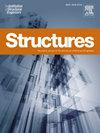Experimental and numerical analysis on the seismic performance of steel joints with slotted holes
IF 3.9
2区 工程技术
Q1 ENGINEERING, CIVIL
引用次数: 0
Abstract
Conventional steel structures typically utilize the plastic deformation of steel to dissipate energy, which causes steel structures to undergo irreversible residual deformation and may even lead to low cycle fatigue fracture under heavy or cyclic loading. To enhance the seismic performance of steel buildings, this study investigated the use of slotted holes in lieu of round holes for connecting plates in steel joints. This modification aims to dissipate seismic energy through friction between steel plates. The present study conducted quasi-static tests on a round-hole bolt joint and a slotted-hole bolt joint. In addition, a finite element parametric study was presented to investigate the effects of friction coefficient, preload, length of the slotted hole straight segment, and position of the slotted hole opening on the behavior of the joints. Compared the test results with the finite element analysis results, it can be found that there was a slight reduction in the peak bearing capacity of the joint using the slotted hole connecting plate (about 11 %). However, the ductility of the slotted hole joints increased by about 30 % and the energy dissipation capacity by about 50 %. The stiffness of the slotted hole joints was not weakened, and its stress level was significantly reduced. The present results can provide experimental reference and data support for the application of slotted hole steel joints in engineering.
求助全文
约1分钟内获得全文
求助全文
来源期刊

Structures
Engineering-Architecture
CiteScore
5.70
自引率
17.10%
发文量
1187
期刊介绍:
Structures aims to publish internationally-leading research across the full breadth of structural engineering. Papers for Structures are particularly welcome in which high-quality research will benefit from wide readership of academics and practitioners such that not only high citation rates but also tangible industrial-related pathways to impact are achieved.
 求助内容:
求助内容: 应助结果提醒方式:
应助结果提醒方式:


